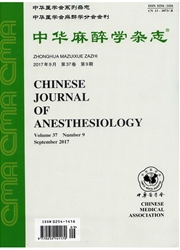

 中文摘要:
中文摘要:
目的 探讨术后认知功能障碍(POCD)小鼠海马微小RNA(miRNA)表达的变化及生物信息学分析.方法 雄性C57BL/6小鼠26只,12~ 14周龄,体重25 ~ 30 g,采用随机数字表法,将其分为2组(n=13):麻醉组(A组)和麻醉+手术组(AS组).A组仅接受异氟醚麻醉,AS组在异氟醚麻醉下行胫骨骨折切开复位内固定术.于术后24 h时2组各取3只小鼠处死,分离海马,进行miRNA微流体芯片分析,筛选差异表达的miRNA;选择3个差异表达的miRNA,采用RT-qPCR法进行验证.应用TargetScan、miRanda和PicTar 3个在线数据库软件对差异表达的5个miRNA(miR-466h-3p、miR-193b-3p、miR-483-5p、miR-181b-5p和miR-98-3p)进行靶基因预测,并对靶基因进行GO生物学功能富集分析和KEGG信号通路富集分析.于术后7d时2组各取10只小鼠,进行场景恐惧记忆实验和声音提示恐惧记忆实验,记录僵直时间百分比.结果 miRNA微流体芯片分析共筛选出22个差异表达的miRNA,其中15个上调,7个下调,RT-qPCR法验证3个miRNA结果与芯片分析结果一致.5个差异表达miRNA的预测靶基因有401个;靶基因主要富集在与认知功能或炎症反应有关的条目.与A组比较,AS组场景恐惧记忆实验中僵直时间百分比降低(P<0.05),而声音提示恐惧记忆实验中僵直时间百分比差异无统计学意义(P>0.05).结论 POCD小鼠海马22个miRNA存在差异表达,这些miRNA可能与POCD的发病机制有关.
 英文摘要:
英文摘要:
Objective To investigate the changes in the expression of hippocampal microRNA (miRNA) and bioinformatics analysis in a mouse model of postoperative cognitive dysfunction (POCD).Methods Twenty-six male C57BL/6 mice,aged 12-14 weeks,weighing 25-30 g,were randomly divided into 2 groups (n=13 each) using a random number table:anesthesia group (group A) and anesthesia+ surgery group (group AS).Group A only received isoflurane anesthesia,and group AS underwent open tibial fracture with intramedullary fixation under general anesthesia with isoflurane.At 24 h after surgery,3 mice were selected from each group and sacrificed,the hippocampi were isolated,and miRNA microarray chip analysis was performed to identify the differentially expressed miRNAs,and quantitative real-time reverse transcriptase polymerase chain reaction was used to verify the differentially expressed miRNAs.The target genes of 5 differentially expressed miRNAs (miR-466h-3p,miR-193b-3p,miR-483-5p,miR-181b-5p,miR-98-3p) were predicted using 3 softwares TargetScan,miRanda,PicTar,and the results were analyzed by using GO functional enrichment and KEGG pathway enrichment analyses.At 7 days after surgery,10 mice were selected from each group,contextual fear conditioning test and tone-cued fear conditioning test were conducted,and the percentage of time spent freezing was recorded.Results miRNA microarray chip analysis revealed that a total of 22 miRNAs were found to be differentially expressed,and among the 22 differentially expressed miRNAs,the expression of 15 miRNAs was significantly up-regulated,and the expression of 7 miRNAs was significantly down-regulated.The results of 3 miRNAs verified by quantitative real-time reverse transcriptase polymerase chain reaction were consistent with the results of miRNA microarray chip analysis.There were 401 predicted target genes of the 5 differentially expressed miRNAs,and they were enriched in several terms related to the development of the cognitive function and inflammatory responses.Co
 同期刊论文项目
同期刊论文项目
 同项目期刊论文
同项目期刊论文
 期刊信息
期刊信息
